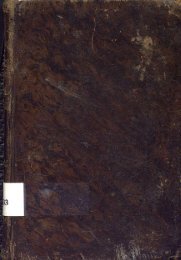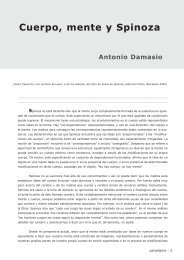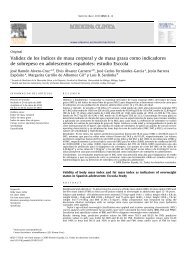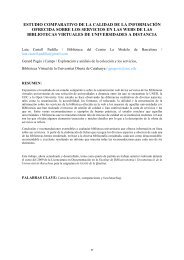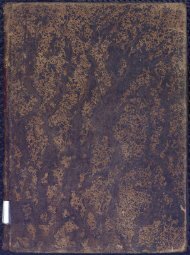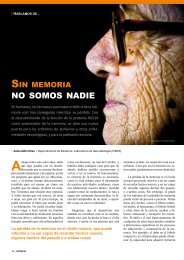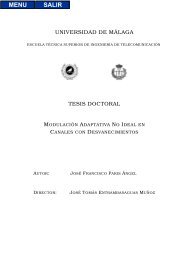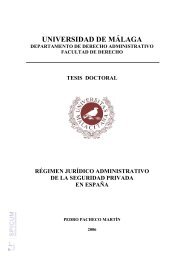Papel de las actividades superóxido dismutasa y catalasa en la ...
Papel de las actividades superóxido dismutasa y catalasa en la ...
Papel de las actividades superóxido dismutasa y catalasa en la ...
You also want an ePaper? Increase the reach of your titles
YUMPU automatically turns print PDFs into web optimized ePapers that Google loves.
Journal of Fish Diseases 2006, 29, 355–364<br />
PDíaz-Rosales et al. Superoxi<strong>de</strong> dismutase and cata<strong><strong>la</strong>s</strong>e in P. damse<strong>la</strong>e ssp. piscicida<br />
in both strains pulsed with hydrog<strong>en</strong> peroxi<strong>de</strong><br />
compared with stationary phase cultures.<br />
Discussion<br />
Enzymes such as SOD and cata<strong><strong>la</strong>s</strong>e, which neutralize<br />
ROS produced during aerobic metabolism or<br />
during respiratory burst in fish phagocytes are<br />
important virul<strong>en</strong>ce factors in many pathog<strong>en</strong>s<br />
(Barnes et al. 1996, 1999b; Yesilkaya, Kadioglu,<br />
Gingles, Alexan<strong>de</strong>r, Mitchell & Andrew 2000;<br />
Vattanaviboon & Mongkolsuk 2001; Uzzau et al.<br />
2002; Banin, Vassi<strong>la</strong>kos, Orr, Martínez & Ros<strong>en</strong>berg<br />
2003). In this study, all the strains of<br />
P. damse<strong>la</strong>e ssp. piscicida assayed showed a single<br />
band of SOD activity with i<strong>de</strong>ntical mobility on<br />
acry<strong>la</strong>mi<strong>de</strong> gels. A unique band simi<strong>la</strong>r in all the<br />
strains was also observed on cata<strong><strong>la</strong>s</strong>e activity gels.<br />
Simi<strong>la</strong>rly, Barnes, Balebona, Horne & Ellis<br />
(1999a), in a study that inclu<strong>de</strong>d a collection of<br />
P. damse<strong>la</strong>e ssp. piscicida strains iso<strong>la</strong>ted from<br />
gilthead seabream, Sparus aurata (L.), reported<br />
only one SOD located in the perip<strong><strong>la</strong>s</strong>mic space and<br />
one cytop<strong><strong>la</strong>s</strong>mic cata<strong><strong>la</strong>s</strong>e.<br />
Several studies have reported that microorganisms<br />
contain differ<strong>en</strong>t SOD and cata<strong><strong>la</strong>s</strong>e isozymes<br />
inducible un<strong>de</strong>r certain growth conditions (Storz,<br />
Tartaglia, Farr & Ames 1990; Privalle & Fridovich<br />
1992; Barnes et al. 1996; Yesilkaya et al. 2000;<br />
Geslin, L<strong>la</strong>nos, Prieur & Jeanthon 2001; Vattanaviboon<br />
& Mongkolsuk 2001). However, culture<br />
conditions assayed in this work have not induced<br />
new SOD or cata<strong><strong>la</strong>s</strong>e isozymes in P. damse<strong>la</strong>e ssp.<br />
piscicida. Mn-SOD activity has be<strong>en</strong> reported to be<br />
modu<strong>la</strong>ted by oxidative stress and iron-limiting<br />
conditions (Privalle & Fridovich 1992; Barnes<br />
et al. 1999b) but in the case of P. damse<strong>la</strong>e ssp.<br />
piscicida neither production of intracellu<strong>la</strong>r superoxi<strong>de</strong><br />
by methyl violog<strong>en</strong> nor culture un<strong>de</strong>r ironrestricted<br />
conditions induced the production of a<br />
differ<strong>en</strong>t type of SOD. Although further studies are<br />
necessary, this <strong>la</strong>ck of induction of a new SOD<br />
could be due to the pres<strong>en</strong>ce of only one sod g<strong>en</strong>e,<br />
i.e. sod B <strong>en</strong>coding Fe-SOD (Lynch & Kuramitsu<br />
2000).<br />
In contrast, differ<strong>en</strong>ces in the int<strong>en</strong>sity of the<br />
bands were observed in extracts obtained un<strong>de</strong>r<br />
differ<strong>en</strong>t culture conditions for both SOD and<br />
cata<strong><strong>la</strong>s</strong>e activities. As the amount of protein loa<strong>de</strong>d<br />
in the electrophoretic <strong>la</strong>nes was simi<strong>la</strong>r in all cases,<br />
the differ<strong>en</strong>t int<strong>en</strong>sities suggest variations in the<br />
levels of activity in the extracts <strong>de</strong>p<strong>en</strong>ding on the<br />
culture condition. These results are in agreem<strong>en</strong>t<br />
with those obtained by Barnes, Balebona, Horne &<br />
Ellis (1999a), who also <strong>de</strong>tected differ<strong>en</strong>ces in<br />
cultures carried out un<strong>de</strong>r iron replete and <strong>de</strong>pleted<br />
conditions and high- and low-aerated broths.<br />
The quantification of both SOD and cata<strong><strong>la</strong>s</strong>e<br />
activities carried out in this study corroborated that<br />
differ<strong>en</strong>t band int<strong>en</strong>sities correspon<strong>de</strong>d to variations<br />
in the levels of activity. The lowest levels of SOD<br />
activity were <strong>de</strong>tected wh<strong>en</strong> bacteria were grown<br />
un<strong>de</strong>r iron-restricted conditions. The ferric nature<br />
of P. damse<strong>la</strong>e ssp. piscicida SOD <strong>de</strong>scribed by<br />
Barnes et al. (1999a) could exp<strong>la</strong>in this lower<br />
activity in the pres<strong>en</strong>ce of an iron che<strong>la</strong>nt.<br />
Iron also influ<strong>en</strong>ced the levels of cata<strong><strong>la</strong>s</strong>e activity<br />
in P. damse<strong>la</strong>e ssp. piscicida. The role of iron as<br />
cofactor in this <strong>en</strong>zyme has be<strong>en</strong> <strong>de</strong>monstrated with<br />
inhibition studies. Thus, cata<strong><strong>la</strong>s</strong>e activity could not<br />
be <strong>de</strong>tected in the gels following exposure to<br />
sodium azi<strong>de</strong> and it was slightly reduced after<br />
treatm<strong>en</strong>t with potassium cyani<strong>de</strong>. These results<br />
suggest that the <strong>en</strong>zyme is an iron cofactored<br />
cata<strong><strong>la</strong>s</strong>e, as Mn-containing cata<strong><strong>la</strong>s</strong>es retain activity<br />
after treatm<strong>en</strong>t with azi<strong>de</strong> and cyani<strong>de</strong> and are<br />
inhibited by mercuric chlori<strong>de</strong> (Kono & Fridovich<br />
1983; Allgood & Perry 1986; Barnes et al. 1999b).<br />
This ferric nature of the cata<strong><strong>la</strong>s</strong>e may exp<strong>la</strong>in the<br />
lower cata<strong><strong>la</strong>s</strong>e activity observed in cultures with<br />
ad<strong>de</strong>d iron che<strong>la</strong>nt and lower survival with H 2 O 2<br />
observed by Díaz-Rosales, Chabrillón, Moriñigo &<br />
Balebona (2003).<br />
Lower survival of P. damse<strong>la</strong>e ssp. piscicida in sole<br />
phagocytes has be<strong>en</strong> observed for strain EPOY-<br />
8803-II compared with the virul<strong>en</strong>t strain. Contradictory<br />
results have be<strong>en</strong> reported on the ability of<br />
P. damse<strong>la</strong>e ssp. piscicida to survive insi<strong>de</strong> macrophages<br />
from several fish species. In a study using<br />
macrophages from sea bass, gilthead sea bream and<br />
rainbow trout, Skarmeta et al. (1995) conclu<strong>de</strong>d<br />
that head kidney macrophages from these fish<br />
species were able to kill the pathog<strong>en</strong>. However,<br />
Noya et al. (1995b) reported that whilst bacteria<br />
within granulocytes and macrophages from <strong>la</strong>rge<br />
gilthead sea bream were morphologically altered,<br />
bacteria insi<strong>de</strong> small fish remained unaffected. In<br />
addition, data on the ability of P. damse<strong>la</strong>e to<br />
survive insi<strong>de</strong> fish macrophages have be<strong>en</strong> reported<br />
by several authors who observed that bacteria can<br />
multiply insi<strong>de</strong> fish macrophages (Kubota et al.<br />
1970; Hawke, P<strong>la</strong>kas, Minton, McPherson, Zin<strong>de</strong>r<br />
& Guarino 1987; Noya et al. 1995a; Elkamel,<br />
Hawke, H<strong>en</strong>k & Thune 2003).<br />
Ó 2006<br />
B<strong>la</strong>ckwell Publishing Ltd<br />
361



